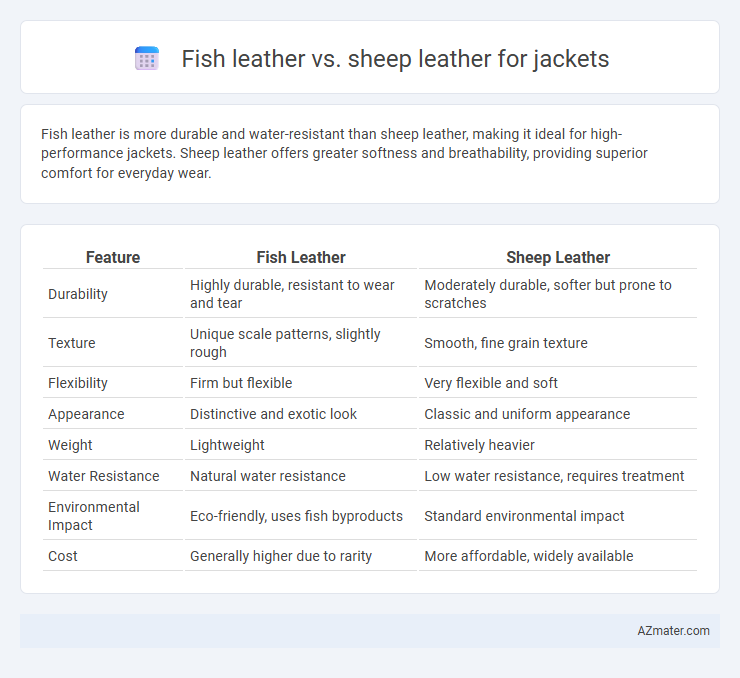Fish leather is more durable and water-resistant than sheep leather, making it ideal for high-performance jackets. Sheep leather offers greater softness and breathability, providing superior comfort for everyday wear.
Table of Comparison
| Feature | Fish Leather | Sheep Leather |
|---|---|---|
| Durability | Highly durable, resistant to wear and tear | Moderately durable, softer but prone to scratches |
| Texture | Unique scale patterns, slightly rough | Smooth, fine grain texture |
| Flexibility | Firm but flexible | Very flexible and soft |
| Appearance | Distinctive and exotic look | Classic and uniform appearance |
| Weight | Lightweight | Relatively heavier |
| Water Resistance | Natural water resistance | Low water resistance, requires treatment |
| Environmental Impact | Eco-friendly, uses fish byproducts | Standard environmental impact |
| Cost | Generally higher due to rarity | More affordable, widely available |
Introduction to Fish Leather and Sheep Leather
Fish leather, derived from byproducts of the fishing industry, offers eco-friendly durability and a unique scale texture, making it a sustainable alternative to traditional hides. Sheep leather is prized for its softness, flexibility, and breathability, commonly used in jackets that require comfort and lightweight protection. Both materials feature distinctive qualities, with fish leather standing out for its strength and water resistance, while sheep leather excels in suppleness and ease of tailoring.
Unique Features of Fish Leather
Fish leather boasts a distinctive texture created by natural scales and patterns, offering a unique visual appeal unmatched by sheep leather. Its remarkable strength and durability stem from dense collagen fibers, making it resistant to tearing and stretching while remaining lightweight. Fish leather's eco-friendly production involves sustainable sourcing and minimal environmental impact, contrasting with the higher carbon footprint of traditional sheep leather.
Distinct Characteristics of Sheep Leather
Sheep leather is renowned for its softness, lightweight feel, and excellent flexibility, making it ideal for comfortable, form-fitting jackets. It features a smooth grain and natural breathability, enhancing wearability in varied climates while maintaining durability. Sheep leather's fine texture and resistance to creasing distinguish it from fish leather's unique scale pattern and stiffness, offering a different tactile and aesthetic appeal.
Sustainability and Environmental Impact
Fish leather requires significantly fewer resources such as water and land compared to sheep leather, making it a more sustainable option for jackets. Its production utilizes byproducts from the fishing industry, reducing waste and minimizing environmental impact. Sheep leather involves higher greenhouse gas emissions and extensive land use, contributing more to deforestation and pollution.
Durability and Strength Comparison
Fish leather, derived mainly from species like salmon and perch, exhibits remarkable durability and tensile strength due to its dense collagen fiber structure, often surpassing sheep leather in resistance to stretching and tearing. Sheep leather, while softer and more pliable, generally offers moderate strength suitable for comfort but may wear out faster under high-stress conditions compared to fish leather. The unique fibrous texture of fish leather contributes to its superior abrasion resistance, making it an excellent choice for long-lasting jackets that maintain structural integrity over time.
Comfort and Wearability
Fish leather offers exceptional breathability and lightweight comfort due to its natural porous structure, making it ideal for jackets worn in varying climates. Sheep leather provides a softer, more flexible feel that molds easily to the body, enhancing wearability for prolonged use. Both materials demonstrate durability, but fish leather's unique texture ensures superior moisture management, while sheep leather excels in stretch and suppleness.
Style and Aesthetic Appeal
Fish leather offers a distinctive, shimmering texture with unique scale patterns that create an eye-catching, exotic aesthetic, making jackets stand out in fashion-forward wardrobes. Sheep leather provides a smooth, supple surface with a classic matte or glossy finish, delivering timeless elegance and versatile style suitable for both casual and formal jackets. The choice between fish and sheep leather ultimately hinges on a preference for bold, unconventional design versus traditional, refined appeal in outerwear.
Care and Maintenance Requirements
Fish leather requires more delicate care than sheep leather due to its thinner, more porous structure, making it susceptible to drying and cracking if not properly moisturized. Sheep leather is more durable and easier to maintain, with higher resistance to water and wear, requiring regular cleaning and conditioning to preserve softness and longevity. Proper storage away from direct sunlight and humidity is essential for both materials to prevent damage and maintain jacket quality.
Price and Market Availability
Fish leather jackets are generally more expensive than sheep leather due to their unique texture and labor-intensive tanning process, with prices often ranging 20-30% higher. Sheep leather is more widely available and affordable, making it the preferred choice in the mass market for jackets. The niche market for fish leather remains limited, primarily serving luxury or eco-conscious consumers, which affects its overall accessibility and price competitiveness.
Choosing the Right Leather for Your Jacket
Fish leather offers exceptional durability and unique textures that make it a sustainable and stylish choice for jacket materials, often outperforming traditional leathers in water resistance and flexibility. Sheep leather provides a softer, more supple feel with excellent breathability, making it ideal for comfortable, lightweight jackets suited for moderate climates. Selecting the right leather depends on balancing durability, texture preferences, climate needs, and sustainability considerations to ensure the jacket meets your functional and aesthetic requirements.

Infographic: Fish leather vs Sheep leather for Jacket
 azmater.com
azmater.com